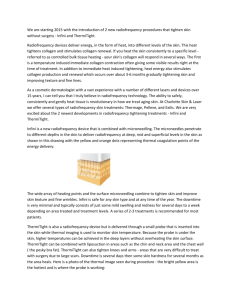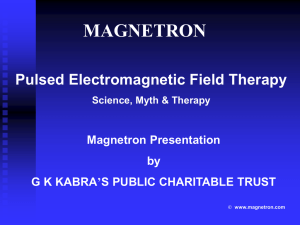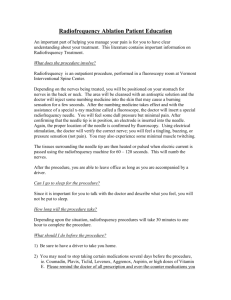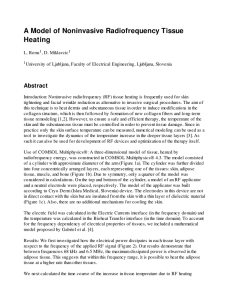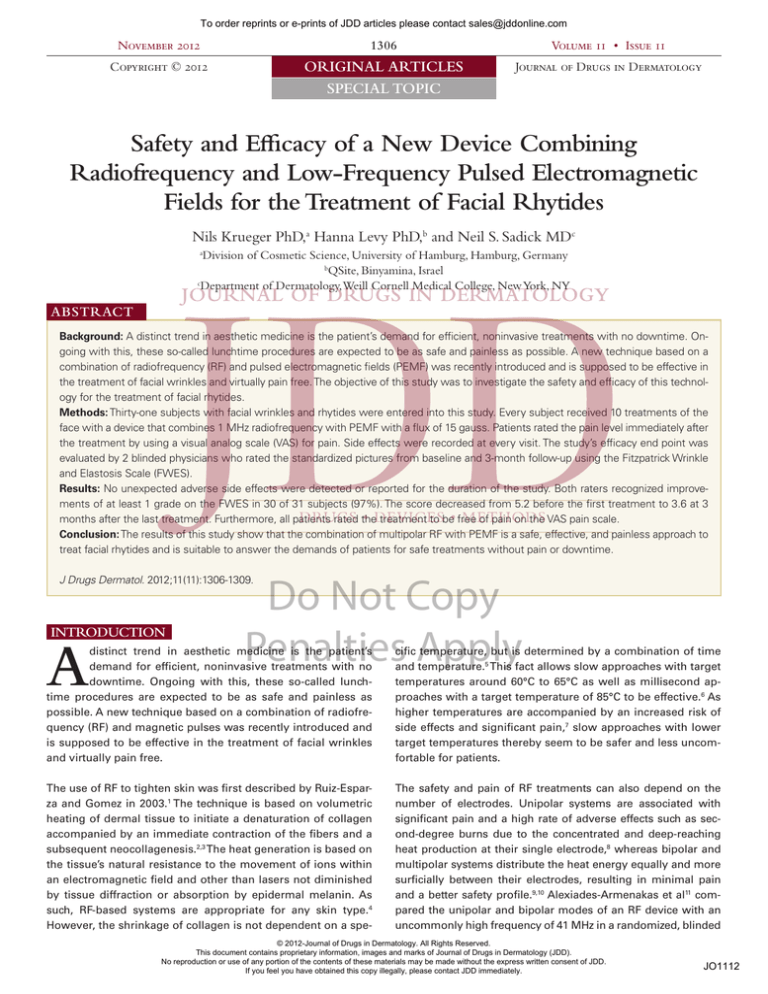
To order reprints or e-prints of JDD articles please contact sales@jddonline.com
November 2012
1306
Volume 11 • Issue 11
Copyright © 2012
ORIGINAL ARTICLES
SPECIAL TOPIC
Journal of Drugs in Dermatology
Safety and Efficacy of a New Device Combining
Radiofrequency and Low-Frequency Pulsed Electromagnetic
Fields for the Treatment of Facial Rhytides
Nils Krueger PhD,a Hanna Levy PhD,b and Neil S. Sadick MDc
Division of Cosmetic Science, University of Hamburg, Hamburg, Germany
b
QSite, Binyamina, Israel
c
Department of Dermatology, Weill Cornell Medical College, New York, NY
a
ABSTRACT
Background: A distinct trend in aesthetic medicine is the patient’s demand for efficient, noninvasive treatments with no downtime. Ongoing with this, these so-called lunchtime procedures are expected to be as safe and painless as possible. A new technique based on a
combination of radiofrequency (RF) and pulsed electromagnetic fields (PEMF) was recently introduced and is supposed to be effective in
the treatment of facial wrinkles and virtually pain free. The objective of this study was to investigate the safety and efficacy of this technology for the treatment of facial rhytides.
Methods: Thirty-one subjects with facial wrinkles and rhytides were entered into this study. Every subject received 10 treatments of the
face with a device that combines 1 MHz radiofrequency with PEMF with a flux of 15 gauss. Patients rated the pain level immediately after
the treatment by using a visual analog scale (VAS) for pain. Side effects were recorded at every visit. The study’s efficacy end point was
evaluated by 2 blinded physicians who rated the standardized pictures from baseline and 3-month follow-up using the Fitzpatrick Wrinkle
and Elastosis Scale (FWES).
Results: No unexpected adverse side effects were detected or reported for the duration of the study. Both raters recognized improvements of at least 1 grade on the FWES in 30 of 31 subjects (97%). The score decreased from 5.2 before the first treatment to 3.6 at 3
months after the last treatment. Furthermore, all patients rated the treatment to be free of pain on the VAS pain scale.
Conclusion: The results of this study show that the combination of multipolar RF with PEMF is a safe, effective, and painless approach to
treat facial rhytides and is suitable to answer the demands of patients for safe treatments without pain or downtime.
Do Not Copy
Penalties Apply
J Drugs Dermatol. 2012;11(11):1306-1309.
INTRODUCTION
A
distinct trend in aesthetic medicine is the patient’s
demand for efficient, noninvasive treatments with no
downtime. Ongoing with this, these so-called lunchtime procedures are expected to be as safe and painless as
possible. A new technique based on a combination of radiofrequency (RF) and magnetic pulses was recently introduced and
is supposed to be effective in the treatment of facial wrinkles
and virtually pain free.
cific temperature, but is determined by a combination of time
and temperature.5 This fact allows slow approaches with target
temperatures around 60°C to 65°C as well as millisecond approaches with a target temperature of 85°C to be effective.6 As
higher temperatures are accompanied by an increased risk of
side effects and significant pain,7 slow approaches with lower
target temperatures thereby seem to be safer and less uncomfortable for patients.
The use of RF to tighten skin was first described by Ruiz-Esparza and Gomez in 2003.1 The technique is based on volumetric
heating of dermal tissue to initiate a denaturation of collagen
accompanied by an immediate contraction of the fibers and a
subsequent neocollagenesis.2,3 The heat generation is based on
the tissue’s natural resistance to the movement of ions within
an electromagnetic field and other than lasers not diminished
by tissue diffraction or absorption by epidermal melanin. As
such, RF-based systems are appropriate for any skin type.4
However, the shrinkage of collagen is not dependent on a spe-
The safety and pain of RF treatments can also depend on the
number of electrodes. Unipolar systems are associated with
significant pain and a high rate of adverse effects such as second-degree burns due to the concentrated and deep-reaching
heat production at their single electrode,8 whereas bipolar and
multipolar systems distribute the heat energy equally and more
surficially between their electrodes, resulting in minimal pain
and a better safety profile.9,10 Alexiades-Armenakas et al11 compared the unipolar and bipolar modes of an RF device with an
uncommonly high frequency of 41 MHz in a randomized, blinded
© 2012-Journal of Drugs in Dermatology. All Rights Reserved.
This document contains proprietary information, images and marks of Journal of Drugs in Dermatology (JDD).
No reproduction or use of any portion of the contents of these materials may be made without the express written consent of JDD.
If you feel you have obtained this copy illegally, please contact JDD immediately.
JO1112
To order reprints or e-prints of JDD articles please contact sales@jddonline.com
1307
Journal of Drugs in Dermatology
November 2012 • Volume 11 • Issue 11
FIGURE 1. Female patient (aged 53 years) before treatment (a) and
after 10 treatments (b).
(a)
(b)
N. Krueger, H. Levy, N.S. Sadick
FIGURE 2. Female patient (aged 50 years) before treatment (a) and
after 10 treatments (b).
(a)
(b)
split-face study on 10 subjects. After 4 treatments at 1-week intervals, both approaches showed improvement of wrinkles and
skin laxity, but no difference in efficacy, pain, or side effects
between the unipolar and bipolar modes.11 Other studies that
directly compare unipolar devices with bipolar or multipolar
devices with more common frequencies (0.5-6.0 MHz) haven’t
been published yet. However, in general, because of their
deeper energy distribution, unipolar devices are supposed to
be more efficient for skin rejuvenation, while bipolar and multipolar devices are supposed to be safer and less painful.
by an immediate contraction of the fibers and a delayed synthesis of collagen and elastin fibers. Furthermore, the nonthermal
mechanism of PEMF does not interfere with the thermal mechanism of the multipolar RF. However, as the effects of PEMF are
well evaluated in vitro, their clinical effects on skin physiology
and their compatibility with radiofrequency are still unclear. The
objective of this study was therefore to investigate the safety
and efficacy of a new device that combines PEMF and multipolar RF for the treatment of facial rhytides.
A new approach to reach a higher efficacy and keep the superior safety and pain profiles of multipolar RF is to combine it
with pulsed electromagnetic fields (PEMF). The therapeutic effects of PEMF were first demonstrated by Bassett et al12 and
have been shown over time in clinical studies to be a safe and
effective treatment for nonhealing bone fractures.13,14 Pulsed
electromagnetic fields upregulate several cytokines such as
bone morphogenetic proteins 2 and 4 and transforming growth
factor-β that are important in promoting osteoblast differentiation during fracture repair.15 Tepper et al showed that PEMF also
has a positive impact on angiogenesis, a process critical for
successful healing of various tissues.16 In their in vitro study,
PEMF increased the degree of endothelial cell tubulization and
proliferation as well as the number of fibroblast growth factor
β-2 (FGF-2) and other angiogenic growth factors. A stimulating effect of PEMF on collagen synthesis was first described by
Murray and Farndale17 and later confirmed by Soda et al,18 who
identified the participation of the p38 mitogen-activated protein
kinase pathway in the process.
The study protocol was approved by the Helsinki committee
of Tel-Aviv Sourasky Medical Center (Israel), and all participants provided verbal and written consent before enrollment.
Thirty-one subjects (30 females, 1 male) with facial wrinkles
and rhytides were entered into the study. Inclusion criteria
involved a score ≥4 on the Fitzpatrick Wrinkle and Elastosis
Scale (FWES).19 Exclusion criteria were pregnancy or nursing, infection or inflammation in the treatment area, history of
hypertrophic scars or keloids, and previous skin rejuvenation
procedures in the face (eg, botulinum toxin, wrinkle or volume
augmentation with an injectable filler, laser or RF treatments) in
the past 6 months.
MATERIALS AND METHODS
Do Not Copy
Penalties Apply
Because multipolar RF and PEMF have different mechanisms
of action and target structures in the skin, their combination
is complementary. The stimulation of neovascularity, fibroblast
proliferation, and collagen neosynthesis by PEMF synergizes
with the denaturation of existing collagen by RF accompanied
Before the first treatment, every patient was digitally photographed with a 10-megapixel camera (Evolt E-420; Olympus,
Tokyo, Japan) in a standardized way. Treatments were performed with a device that combines 1 MHz RF with PEMF with
a frequency of 15 Hz and a pulse duration of 0.5 ms (Venus
FreezeTM; Venus Concept, Karmiel, Israel). The magnetic field
flux was 15 gauss (0.0015 tesla). Immediately after treatment,
the treated area was visually assessed for skin responses,
including edema, erythema, hypopigmentation or hyperpigmentation, and textural changes. In addition, patients were
asked to rate the pain level perceived during the treatment by
using a visual analog scale (VAS) for pain.
© 2012-Journal of Drugs in Dermatology. All Rights Reserved.
This document contains proprietary information, images and marks of Journal of Drugs in Dermatology (JDD).
No reproduction or use of any portion of the contents of these materials may be made without the express written consent of JDD.
If you feel you have obtained this copy illegally, please contact JDD immediately.
JO1112
To order reprints or e-prints of JDD articles please contact sales@jddonline.com
1308
Journal of Drugs in Dermatology
November 2012 • Volume 11 • Issue 11
FIGURE 3. Change in Fitzpatrick Wrinkle and Elastosis Scale.
N. Krueger, H. Levy, N.S. Sadick
Safety and Pain
No unexpected adverse side effects were detected or reported
for the duration of the study. In some patients, posttreatment
edema was detected, which resolved within 10 to 30 minutes
without further treatment. No patients experienced more
serious side effects like burns, skin breakdown, or scarring. Furthermore, all patients rated the treatment to be free of pain on
the VAS pain scale.
Efficacy
The effect of the combination approach with RF and PEMF on
facial rhytides was evaluated by 2 blinded physicians using the
FWES. The comparison of the pictures (Figures 1-2) showed a
statistically significant (P<.001) decrease in the average FWES
score from 5.2 before the first treatment to 3.6 at 3 months after the last treatment (Figure 3). The median difference was 1.5
overall. Both independent raters recognized improvements of at
least 1 grade on the FWES in 30 of 31 subjects (96.8%) (Figure 4).
FIGURE 4. Responder rate.
DISCUSSION
Every subject received 10 treatments of the face with individual
treatment time and energy output adjusted to skin type. While the
first 4 treatments were performed twice weekly, the following treatments were performed once a week. At follow-ups 1 month and 3
months after the last treatment, every patient was photographed
in the same way as at the baseline visit. To evaluate the safety of
the procedure, the occurrence of potential procedure-related side
effects was monitored through the whole study. The study’s efficacy end point was evaluated by 2 blinded physicians who rated the
standardized pictures from baseline and 3-month follow-up using
the FWES.19 In addition to the average score change, the responder
rate was calculated by summarizing the number of subjects with
an improvement of at least 1 grade on the FWES.
The treatment of photoaged skin and signs of intrinsic aging
was for a long time limited to ablative or minimal ablative approaches and, therefore, was associated with complications
like prolonged erythema, infections, pigmentary alterations, or
scarring.20 The use of RF for facial and whole-body rejuvenation
answers the demand of patients for noticeable improvement
in combination with minimal risk and no downtime. The heat
generated by the electric current causes a collagen contracture
and remodeling deep in the dermis without appreciable epidermal disruption.2 The main disadvantage of this technology was
the level of pain generated by the first-generation RF devices.7
Subsequent generations of RF devices were developed to optimize the balance between clinical efficacy, safety, and pain.
Therefore, the latest development is the use of multipolar RF in
combination with PEMF for gentle tissue heating.10
Do Not Copy
Penalties Apply
The software program SPSS Statistics 19 (IBM Corporation,
Armonk, NY) was used for data preparation and statistical
analysis. Mean, median, standard deviation, and standard error were calculated for every parameter. To identify statistically
significant differences between baseline and follow-up, a significance level of .05 was determined and the nonparametric
Wilcoxon signed rank test was used.
RESULTS
All 31 enrolled patients finished the study, including the
3-month follow-up, and were included in the analysis. The subjects ranged in age from 36 to 62 years (mean, 49.2±7.2) years.
The results of this study show that the combination of multipolar RF with PEMF is a safe, effective, and painless approach to
treat facial rhytides. The rejuvenating effect, determined by an
increase of at least 1 grade on the FWES, was ascertainable in
30 of 31 subjects (97%). The high responder rate together with
the overall median decrease of 1.5 grades demonstrates that the
efficacy of the combination approach evaluated in this study is
noninferior or superior to approaches with unipolar or bipolar
RF. Other studies using the FWES showed a responder rate of
83% to 100% with unipolar RF21,22 and 85% to 100% with bipolar
RF.9,23,24 Particularly in studies investigating unipolar RF, the good
efficacy was associated with mild to moderate pain levels and
a high rate of side effects. Fitzpatrick et al21 described erythema (36%), edema (14%), second-degree burns (6%), and scars
(3%) as side effects of the procedure. In studies on bipolar RF,
largely no pain was described, although transient erythema and
edema as well as burn/blistering, purpura, crusting, and tran-
© 2012-Journal of Drugs in Dermatology. All Rights Reserved.
This document contains proprietary information, images and marks of Journal of Drugs in Dermatology (JDD).
No reproduction or use of any portion of the contents of these materials may be made without the express written consent of JDD.
If you feel you have obtained this copy illegally, please contact JDD immediately.
JO1112
To order reprints or e-prints of JDD articles please contact sales@jddonline.com
1309
Journal of Drugs in Dermatology
November 2012 • Volume 11 • Issue 11
sient hyperpigmentation occurred.9,23 In the current study, there
was no pain experienced by any of the subjects during or posttreatment. The only observed side effect was edema in some
patients, which resolved within 30 minutes after the treatment.
CONCLUSION
This uncontrolled pilot study demonstrates that the combination of multipolar RF with PEMF is an efficient and gentle
approach for the treatment of facial rhytides. It is suitable to
answer the demands of patients for safe treatments without
pain or downtime. However, further studies in a randomized
controlled design are necessary to confirm the results of this
study and to evaluate the applicability of this technology for
skin tightening of nonfacial areas or the treatment of other indications like cellulite or stretch marks.
N. Krueger, H. Levy, N.S. Sadick
17. Murray JC, Farndale RW. Modulation of collagen production in cultured fibroblasts by a low-frequency, pulsed magnetic field. Biochim Biophys Acta.
1985;838(1):98-105.
18. Soda A, Ikehara T, Kinouchi Y, Yoshizaki K. Effect of exposure to an extremely
low frequency-electromagnetic field on the cellular collagen with respect to
signaling pathways in osteoblast-like cells. J Med Invest. 2008;55(3-4):267278.
19. Fitzpatrick RE, Goldman MP, Satur NM, Tope WD. Pulsed carbon dioxide laser
resurfacing of photo-aged facial skin. Arch Dermatol. 1996;132(4):395-402.
20. Metelitsa AI, Alster TS. Fractionated laser skin resurfacing treatment complications: a review. Dermatol Surg. 2010;36(3):299-306.
21. Fitzpatrick R, Geronemus R, Goldberg D, Kaminer M, Kilmer S, Ruiz-Esparza
J. Multicenter study of noninvasive radiofrequency for periorbital tissue
tightening. Lasers Surg Med. 2003;33(4):232-242.
22. Tay YK, Kwok C. A novel radiofrequency device for the treatment of rhytides
and lax skin: a pilot study. J Cosmet Laser Ther. 2009;11(1):25-28.
23. Willey A, Kilmer S, Newman J, et al. Elastometry and clinical results after bipolar radiofrequency treatment of skin. Dermatol Surg. 2010;36(6):877-884.
24. Harth Y, Lischinsky D. A novel method for real-time skin impedance measurement during radiofrequency skin tightening treatments. J Cosmet Dermatol.
2011;10(1):24-29.
AUTHOR CORRESPONDENCE
DISCLOSURES
Neil S. Sadick is a consultant for Venus Concept and owns stock
options in the company.
Neil S. Sadick MD
E-mail:................……...................nssderm@sadickdermatology.com
REFERENCES
1.
2.
3.
4.
5.
6.
7.
8.
9.
10.
11.
12.
13.
14.
15.
16.
Ruiz-Esparza J, Gomez JB. The medical face lift: a noninvasive, nonsurgical
approach to tissue tightening in facial skin using nonablative radiofrequency.
Dermatol Surg. 2003;29(4):325-332.
Zelickson BD, Kist D, Bernstein E, et al. Histological and ultrastructural evaluation of the effects of a radiofrequency-based nonablative dermal remodeling device: a pilot study. Arch Dermatol. 2004;140(2):204-209.
Drew PJ, Watkins A, McGregor AD, Kiernan MN, Clement M. The effects of
temperature and time on thermal bond strength in tendons. Lasers Med Sci.
2001;16(4):291-298.
Alster TS, Lupton JR. Nonablative cutaneous remodeling using radiofrequency devices. Clin. Dermatol. 2007;25(5):487-491.
Atiyeh BS, Dibo SA. Nonsurgical nonablative treatment of aging skin: radiofrequency technologies between aggressive marketing and evidence-based
efficacy. Aesthetic Plast Surg. 2009;33(3):283-294.
Ruiz-Esparza J. Near [corrected] painless, nonablative, immediate skin contraction induced by low-fluence irradiation with new infrared device: a report
of 25 patients. Dermatol Surg. 2006;32(5):601-610.
Sadick NS, Makino Y. Selective electro-thermolysis in aesthetic medicine: a
review. Lasers Surg Med. 2004;34(2):91-97.
de Felipe I, Del Cueto SR, Pérez E, Redondo P. Adverse reactions after
nonablative radiofrequency: follow-up of 290 patients. J Cosmet Dermatol.
2007;6(3):163-166.
Gold MH, Goldman MP, Rao J, Carcamo AS, Ehrlich M. Treatment of wrinkles
and elastosis using vacuum-assisted bipolar radiofrequency heating of the
dermis. Dermatol Surg. 2007;33(3):300-309.
Royo de la Torre J, Moreno-Moraga J, Muñoz E, Cornejo Navarro P. Multisource, Phase-controlled Radiofrequency for Treatment of Skin Laxity: Correlation Between Clinical and In-vivo Confocal Microscopy Results and RealTime Thermal Changes. J Clin Aesthet Dermatol. 2011;4(1):28-35.
Alexiades-Armenakas M, Dover JS, Arndt KA. Unipolar versus bipolar radiofrequency treatment of rhytides and laxity using a mobile painless delivery
method. Lasers Surg Med. 2008;40(7):446-453.
Bassett CA, Pawluk RJ, Pilla AA. Augmentation of bone repair by inductively
coupled electromagnetic fields. Science. 1974;184(4136):575-577.
Sharrard WJ. A double-blind trial of pulsed electromagnetic fields for delayed
union of tibial fractures. J Bone Joint Surg Br. 1990;72(3):347-355.
Ryaby JT. Clinical effects of electromagnetic and electric fields on fracture
healing. Clin Orthop Relat Res. 1998;(355 Suppl):S205-S215.
Bodamyali T, Bhatt B, Hughes FJ, et al. Pulsed electromagnetic fields simultaneously induce osteogenesis and upregulate transcription of bone morphogenetic proteins 2 and 4 in rat osteoblasts in vitro. Biochem Biophys Res
Commun. 1998;250(2):458-461.
Tepper OM, Callaghan MJ, Chang EI, et al. Electromagnetic fields increase
in vitro and in vivo angiogenesis through endothelial release of FGF-2. FASEB
J. 2004;18(11):1231-1233.
Do Not Copy
Penalties Apply
© 2012-Journal of Drugs in Dermatology. All Rights Reserved.
This document contains proprietary information, images and marks of Journal of Drugs in Dermatology (JDD).
No reproduction or use of any portion of the contents of these materials may be made without the express written consent of JDD.
If you feel you have obtained this copy illegally, please contact JDD immediately.
JO1112


